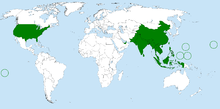Bactrocera dorsalis
| Bactrocera dorsalis | |
|---|---|
 |
|
| Scientific classification | |
| Kingdom: | Animalia |
| Phylum: | Arthropoda |
| Class: | Insecta |
| Order: | Diptera |
| Family: | Tephritidae |
| Genus: | Bactrocera |
| Subgenus: | Bactrocera |
| Species: | B. dorsalis |
| Binomial name | |
|
Bactrocera dorsalis (Hendel, 1912) |
|
 |
|
| Bactrocera dorsalis range | |
| Synonyms | |
|
Dacus dorsalis |
|
Dacus dorsalis
Bactrocera dorsalis is a species of tephritid fruit fly that is endemic to Southeast Asia, but has also been introduced to Hawaii, the Mariana Islands and Tahiti. It is one of the major pest species in the genus Bactrocera with a broad host range of cultivated and wild fruits.
It is similar to the closely related species B. carambolae and B. occipitalis, and recent scientific evidence showed that B. papayae, B. invadens and B. philippinensis belong to the same biological species as B. dorsalis.
Males of the species respond strongly to methyl eugenol and this is used for monitoring and estimating populations. They are also important pollinators/visitors of wild orchids, Bulbophyllum cheiri and Bulbophyllum vinaceum, in Southeast Asia, which lure the flies using methyl eugenol.
Mated female B. dorsalis punctures the skin of mature fruit and deposit eggs in few batches depending on the quality of the fruit. Eggs then hatch to larvae and moult twice while feeding on the flesh of the fruit. The third instar larvae exits the fruit and burrow into the soil to pupate. In a week or two the adult emerges from the pupae and within a week they became mature and mating continues.
The insect was eliminated from Miami-Dade County in Florida in February 2016, where it was detected in August 2015.
...
Wikipedia
